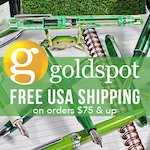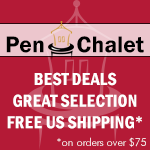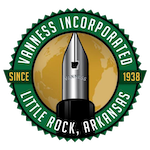(Ron Gilmour is a fountain pen enthusiast, would-be calligrapher, and librarian. You can find him online at Twitter @gilmour70 and Instagram.)
The vibrant online pen community, of which many Pen Addict readers and listeners are a part of, concerns itself primarily with modern pens. This is understandable, as modern pens are easily available and are consistent enough for reviews to be meaningful. For those who have no experience with vintage pens, the vintage world may seem like a foreign and sometimes puzzling place.
This posts and its successors are a modest attempt at encouraging the "modernists" among Pen Addict readers to dip their toes into the vintage world, which I swear isn't scary. These posts were inspired by an excellent post from Dr. Deans of Pen Economics entitled "Why Aren't Vintage Pens More Popular?".
Here's the plan. In this post, I will address a few common myths about vintage fountain pens, which I hope will convince you that they are worth trying out. In succeeding posts, I will highlight a few major vintage pen models that are easy to find, affordable, and reliable. On with the myths!
Vintage Pens are Expensive
Well, yes, some of them are, but so are some modern pens. The two major factors that account for high prices on vintage pens are condition and scarcity.
At the risk of stating the obvious, vintage pens have been around for a while. Some of the most popular models date from the 1930s and '40s. Some have had multiple owners, not all of whom may have been fastidious in their pen care habits. Consequently, if you insist on a pen in perfect condition, you can expect to pay for it. If you aren't too picky about aesthetics, you can get some great deals.
(Vocabulary note: If you see a vintage pen advertised as "NOS," that means "new old stock." Such a pen is as it came from the manufacturer and has presumably been sitting in a warehouse since WWII. Which is kind of sad, but great news if you want a pristine example of a vintage pen.)
The other major factor that can drive up the price of the pen is scarcity. This is a simple matter of supply and demand. If you're chasing down a rare pen, you can expect to pay quite a bit for it when you find it. If you're in the market for a vintage Sheaffer Balance and you're not picky about color, you can easily find one under $100 US (subject to condition), but if you must have it in the lovely "rose glow" color, expect to pay.
Recently, a possible third factor has emerged: flex. Pens with flexible nibs generally command a somewhat higher price than pens with firm nibs. This factor may become even more significant as the trendiness of flex nibs increases and fountain pen users frustrated with the sad state of "modern flex" wisely opt for vintage pens.
Vintage Pens are Hard to Buy
The many wonderful vendors who serve the modern pen community have spoiled us. They provide extensive information, detailed photos, and customer reviews about their products. Many of their websites are lovely. In contrast, Dr. Deans has compared the sites of some vintage vendors to Soviet prison camps. A little harsh, but many have at least a hint of the late '90s about them. Many vintage vendors are small (sometimes one-person) shops. They may not have professional photographers, web designers, or data-entry minions.
It might help to think of your transactions with vintage pen dealers as more like ordering a custom pen from Edison Pens or Shawn Newton than like ordering the latest TWSBI from Goulet Pens. It might take a few emails to secure the sale, but that gives you a chance to ask questions and engage with a fountain pen expert!
Keeping one's stock up-to-date on a website is a time-consuming task, especially when every item is unique. Vintage vendors may have items that aren't currently listed. If you tell a vendor what you're looking for, they can often oblige, even if the item isn't listed on their site. (That said, don't go asking vintage sellers about items outside their usual range of interest. It does no good to inquire about a vintage Pelikan from a vendor whose site clearly indicates a specialization in American pens.)
I've spoken so far about obtaining pens from specialist vendors, which is by far the safest way to go. The second best way is through non-vendor ads on the various fountain pen forums. My experience buying from the forums has been very good. Read the descriptions carefully, examine the photos, use common sense, and you'll probably have a good experience.
The final way to find a vintage pen is through online auction sites. This is a far riskier way to buy a pen. Personally, I only buy pens from online auction sites if the seller is a fountain pen specialist. Auction sites are filled with "I found this in mama's attic" ads and you should avoid those. A red flag is that non-pen-dealers on auction sites seem to describe everything as "rare," despite the fact that there are dozens of that model listed for sale. If the seller thinks a Pelikan 120 is "rare," then you don't want to buy from them.
At this point I'll mention a price factor that I omitted above: the reputation of the vendor. Other factors being equal, you may pay more for a pen from a reputable vintage dealer than from an auction site or a random ad on FPN. Personally, I regard the extra cost as a good investment. Specialist vintage dealers have reputations to protect and do not want unhappy customers. They have extensive knowledge of vintage pens and restoration methods. Sometimes they will even offer limited warranties. Going after the "too good to be true" deal from an unknown seller on an auction site is a recipe for disappointment.
Vintage Pens have Freaky Filling Mechanisms
Over the decades, there has been a winnowing of filling mechanisms. Most modern pens are either piston fillers or cartridge/converter pens. There has been a recent revival of interest in vacuum fillers (e.g., Pilot and TWSBI) and Edison Pens produces modern versions of the classic pump filler and pneumatic mechanisms.
In Days of Yore, there were far more filling systems and companies competed in developing mechanisms that maximized ink capacity and minimized mess. Many of these systems are based around a "sac" or "bladder," a flexible ink container inside the pen. If you've ever used a squeeze converter from Pilot or Kaweco, you get the idea. Several filling systems used such an internal sac and were named for whatever mechanism was used to compress and expand that sac, but they're just variations on the "sac filler" theme. This includes lever-fillers, button-fillers, crescent-fillers, and others.
But sac fillers have drawbacks, as one might guess from their virtual absence in the modern fountain pen market. Sacs break down and require replacement. People tell me this is easy, but I've yet to try it myself. I'm not a very handy person and I prefer to send the pen to a repair person.
Furthermore, the ink capacity of a sac-filling pen is limited by the thickness of the sac wall itself. Maximum ink capacity requires a method that will fill the whole barrel with ink. Thus the one-time popularity of the Parker's "vacumatic" filler and the continuing enthusiasm for piston fillers.
Think of all this as a source of fun. I've yet to purchase a vintage pen that I couldn't fill and I doubt that you will either. At worst, you'll have to search YouTube.
I'll discuss filling mechanisms in more detail in later posts as they apply to specific models.
Vintage Pens are Delicate / Hard to Care For
Remember that vintage pens were created in an age when everyone used fountain pens, but when most people couldn't afford an arsenal of them. Many vintage fountain pens are tanks--built for daily use indefinitely.
I don't like to carry pens around. Most of my pens live at home, but I always have a pen or two at the office. I'll swap the "office pen" out every month or so. To qualify as an office pen, a pen must be drama free. I don't have time at work to fuss with a troublesome pen. And most of my office pens are vintage.
Nevertheless, there is a real possibility that you might need to have your vintage pens repaired at some point. Most of mine have made a trip to the repair shop at some point. Such repairs thus far have been fast and affordable, usually just involving replacing a sac or similar. There are plenty of good pen repairers out there and they are easily found by asking around on social media or perusing fountain pen web sites. The number of vintage pens I've sent off for repair roughly equals the number of modern pens that I've sent off to have their nibs adjusted, so I wouldn't count repair as an added cost for vintage.
A final note on caring for vintage pens: the ink question. Many owners of vintage pens, myself included, prefer to be conservative in their ink selections. Richard Binder has an excellent article on inks, and you may wish to stick to his recommendations for "safe" inks and save the sparkling, shimmering, and laser-proof inks for your modern pens. I recommend this primarily because modern pens are usually easier to thoroughly clean than vintage pens.
I hope that you've enjoyed this post and will stay tuned for the model-specific posts to come.



















































